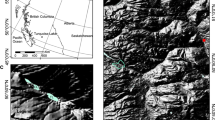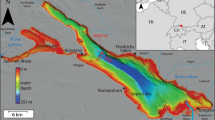Abstract
New sediment core data from a unique slow-sedimentation rate site in Lake Tanganyika contain a much longer and continuous record of limnological response to climate change than have been previously observed in equatorial regions of central Africa. The new core site was first located through an extensive seismic reflection survey over the Kavala Island Ridge (KIR), a sedimented basement high that separates the Kigoma and Kalemie Basins in Lake Tanganyika.
Proxy analyses of paleoclimate response carried out on core T97-52V include paleomagnetic and index properties, TOC and isotopic analyses of organic carbon, and diatom and biogenic silica analyses. A robust age model based on 11 radiocarbon (AMS) dates indicates a linear, continuous sedimentation rate nearly an order of magnitude slower here compared to other core sites around the lake. This age model indicates continuous sedimentation over the past 79 k yr, and a basal age in excess of 100 k yr.
The results of the proxy analyses for the past ∼ 20 k yr are comparable to previous studies focused on that interval in Lake Tanganyika, and show that the lake was about 350 m lower than present at the Last Glacial Maximum (LGM). Repetitive peaks in TOC and corresponding drops in δ13C over the past 79 k yr indicate periods of high productivity and mixing above the T97-52V core site, probably due to cooler and perhaps windier conditions. From ∼ 80 through ∼ 58 k yr the δ13C values are relatively negative (−26 to −28 l) suggesting predominance of algal contributions to bottom sediments at this site during this time. Following this interval there is a shift to higher values of δ13C, indicating a possible shift to C-4 pathway-dominated grassland-type vegetation in the catchment, and indicating cooler, dryer conditions from ∼ 55 k yr through the LGM. Two seismic sequence boundaries are observed at shallow stratigraphic levels in the seismic reflection data, and the upper boundary correlates to a major discontinuity near the base of T97-52V. We interpret these discontinuities to reflect major, prolonged drops in lake level below the core site (393 m), with the lower boundary correlating to marine oxygen isotope Stage 6. This suggests that the previous glacial period was considerably cooler and more arid in the equatorial tropics than was the last glacial period.
Similar content being viewed by others
References
Butzer K.W., Isaac G.L., Richardson J.L. and Washbourn-Kamau C. 1972. Radiocarbon dating of East African lake levels. Science 175: 1069–1076.
Cohen A.S., Soreghan M. and Scholz C.A. 1993. Estimating the age of formation of lakes: An example from Lake Tanganyika, East African Rift system. Geology 21: 511–514.
Cohen A.S., Lezzar K.E., Tiercelin J.J. and Soreghan M. 1997a. New paleogeographic and lake level reconstructions of Lake Tanganyika: implications for tectonic, climatic, and biological evolution in a rift lake. Basin Res. 9/2: 107–132.
Cohen A.S., Talbot M.R., Awramik S.M., Dettman D.L. and Abell P. 1997b. Lake level and paleoenvironmental history of Lake Tanganyika. Geol. Soc. Am. Bull. 109: 444–460.
Coulter G.W. and Tiercelin J.-J. 1991. tLake Tanganyika and Its Life. Oxford University Press, London, 354 pp.
deMenocal P.B. 1995. Plio-Pleistocene African Climate. Science 270: 53–59.
Gasse F., Ledee V., Massault M. and Fontes J.-C. 1989. Water-level fluctuations in-phase with oceanic changes during the last glaciation and deglaciation. Nature 342: 57–59.
Haberyan K.A. and Hecky R.E. 1987. The late-Pleistocene and Holocene stratigraphy and paleolimnology of Lakes Kivu and Tanganyika. Palaeogeogr. Palaeoclimat. Palaeoecol. 61: 169–197.
Hecky R.E. and Degens E.T. 1973. Late-Pleistocene chemical stratigraphy and paleolimnology of the rift valley lakes of Central Africa. Woods Hole Oceanogr. Inst., Tech. Report No. 73-28, 93 pp.
Hillaire-Marcel C., Aucour A.-M., Bonnefille R., Riollet G., Vincens A. and Williamson D. 1989. 13C/palynological evidence of differential residence times of organic carbon prior to its sedimentation in East African rift lakes and peat bogs. Quat. Sci. Rev. 8: 207–212.
Johnson T.C., Barry S.L. Chan. Y. and Wilkinson P. 2001. Decadal record of climate variability spanning the past 700 years in the southern tropics of East Africa. Geology 29: 83–86.
Johnson T.C. 1996. Sedimentary processes and signals of past climate change in the lakes of the East African Rift Valley. In: Johnson T.C. and Odada E. (eds), The Limnology, Climatology, and Paleoclimatology of the East African Lakes. Gordon and Breach, Amsterdam, pp. 367–412.
Jones G.A. and Kaiteris P. 1983. A vacuum-gasometric technique for rapid and precise analysis of calcium carbonate in sediments and soils. J. Sed. Petrol. 53: 2: 655–660.
Karlin R. and Levi S. 1983. Diagenesis of magnetic minerals in Recent hemipelagic sediments. Nature 303: 5915: 327–330.
Lezzar K.E., Tiercelin J.-J., De Baptist M., Cohen A.S., Bandora T., Van Rensbergen P., Le Turdu C., Mifundu W. and Klerx J. 1996. New seismic stratigraphy and late-Tertiary history of the north Tanganyika basin, East African Rift system, deduced from multichannel and high-resolution reflection seismic data and piston core evidence. Basin Res. 8: 1–28.
Livingstone D.A. 1965. Sedimentation and the history of water level change in Lake Tanganyika. Limnol. Oceanogr. 10: 249–280.
McIntyre A. and Molfino B. 1996. Forcing of Atlantic equatorial and subpolar millennial cycles by precession. Science 274: 5294: 1867-1870.
Petit J.R., Jouzel J., Raynaud D., Barkov N.I., Barnola J.M., Basile I., Bender M., Chappellaz J.M., Davis G., Delaygue M., Delmotte V.N., Kotlyakov M., Legrand M., Lipenkov V.Y, Lorius C., Pepin L., Ritz C., Saltzmann E. and Stievenard M. 1999. Climate and atmospheric history of the past 420,000 years from the Vostok ice core, Antarctica. Nature 399: 6735: 429-436.
Plisnier P.D., Chitamwebwa D., Mwape L., Tshibangu K., Langenberg V. and Coenen E. 1999. Limnological annual cycle inferred from physical-chemical fluctuations at three stations of Lake Tanganyika. Hydrobiologia 407: 45–58.
Pokras E.M. and Mix A.C. 1987. Earth's precession cycle and Quaternary climatic change in tropical Africa. Nature 326: 486–487.
Rosendahl B.R., 1987. In: Wetherill G.W. (ed.), Architecture of continental rifts with special reference to East Africa. Ann. Rev. Earth Planet. Sci. 15: 445–503.
Scholz C.A. and Rosendahl B.R. 1988. Low lake stands in Lakes Malawi and Tanganyika, East Africa, delineated with multifold seismic data. Science 240: 1645–1648.
Schulz H., von Rad U. and Erlenkeuser H. 1998. Correlation between Arabian Sea and Greenland climate oscillations of the past 110,000 years. Nature 393: 6680: 54-57.
Shackleton N.J. 1983. The evolution of Pleistocene climatic variability. In: Ghazi A. (ed.), Palaeoclimatic Research and Models, Report and Proceedings of Workshop, Brussels, Belgium, Dec. 15-17, 1982.
Short D.A., Mengel J.G., Crowley T.J., Hyde W.T. and North G.R. 1991. Filtering of Milankovitch Cycles by earth's geography. Quat. Res. 25: 157–173.
Street-Perrott F.A., Huang Y., Perrott R.A., Eglinton G., Barker P., Khelifa L.B., Harkness D.D. and Olago D.O. 1997. Impact of lower atmospheric carbon dioxide on tropical mountain ecosystems. Science 278: 1422–1426.
Stuiver M. and Reimer P. 1993. Extended 14C data base and revised CALIB 3.0 14C age calibration program. Radiocarbon 35: 1: 215-230.
Talbot M.R. and Laerdal T. 2000. The Late Pleistocene-Holocene paleolimnology of Lake Victoria, East Africa, based upon elementary and isotopic analyses of sedimentary organic matter. J. Paleolim. 23: 141–164.
Talbot M.R. and Delibrias G. 1980. A new late Pleistocene-Holocene water-level curve for Lake Bosumtwi, Ghana. Earth and Planet. Sci. Lett. 47(3): 336–344.
Tiercelin J.-J., Mondeguer A., Gasse F., Hillaire-Marcel C., Hoffert M., Larque P., Ledee V., Marestang P., Ravenne C., Raynaus J.F., Thouveny N., Vincens A. and Williamson D. 1988. 25000 ans d'histoire hydrologique et sedimentaire du lac Tanganyika, Rift Est-africain [25000 years of hydrologic and sedimentary history of Lake Tanganyika, East African Rift], C.r. Acad. Sci., Paris, t 307: 1375–1382.
Tiercelin J.-J., Scholz C.A., Mondeguer A., Rosendahl B.R. and Ravenne C. 1989. Discontinuites sismiques et sedimentaires dans la serie de remplissage du fosse du Tanganyika, Rift Est Africain [Seismic and sedimentary discontinuities in the Lake Tanganyika Rift, East Africa], C.r. Acad. Sci., Paris, t. 309: 1599–1606.
Author information
Authors and Affiliations
Rights and permissions
About this article
Cite this article
Scholz, C.A., King, J.W., Ellis, G.S. et al. Paleolimnology of Lake Tanganyika, East Africa, over the past 100 kyr. Journal of Paleolimnology 30, 139–150 (2003). https://doi.org/10.1023/A:1025522116249
Issue Date:
DOI: https://doi.org/10.1023/A:1025522116249




